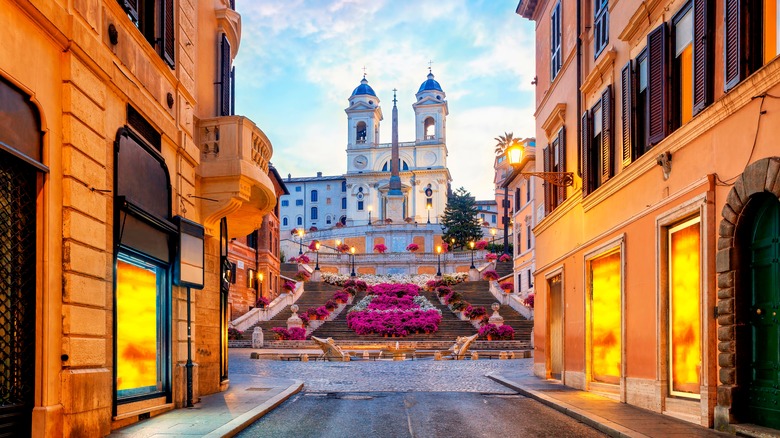Rome's Baroque 'Monster House' Is An Architectural And Artistic Dream
Packed with renowned cultural treasures and landmarks like the Colosseum and the Sistine Chapel, Rome also has its share of relatively unknown attractions. With so much to see — and so much pizza, pasta, and gelato to eat — seeking out lesser-known sights can sink to the bottom of your to-do list. Fortunately for lovers of the city's remarkable architecture, The Palazzo Zuccari — aka the Monster House — is not only located near many of the famous places on travelers' checklists, but you'll most likely only be able to see it from the outside, saving time.
A Mannerist painter named Federico Zuccari designed the whimsical Baroque door and windows for his home in 1590. He was one of Europe's most in-demand artists who traveled extensively for commissions by the likes of Queen Elizabeth of England, and he contributed to masterpieces like the Florence Cathedral's notable Duomo. Faces carved into the stone above the large door and small windows that flank it suggest mouths open wide as if yelling or preparing to eat visitors — they look otherworldly and angry, hence the comparison to monsters.
To get there, simply climb the Spanish Steps in central Rome, turn right, and you will see a fork in the road. Via Sistina and Via Gregoriana split and the building in between them is the Palazzo Zuccari, with the famous monster façade located at Via Gregoriana 30.
About the Palazzo Zuccari
Palazzo Zuccari was inspired by the Gardens of Bomarzo, which have similar-looking fantastical sculptures and were commissioned 40 years earlier. It's thought that the monsters would have showcased Federico Zuccari's creativity and added to the surprise of visitors who might have been hesitant to enter, but then became delighted by the traditionally beautiful interior and gardens of his palazzo.
The building has had myriad uses over the years, many of them pertaining to art. It belonged to the former Queen of Poland in the early 18th century when one of its functions was a cultural center. It was Zuccari's hope that his creation would house other artists, and his wish came true. The palazzo served as a residence for the English painter Sir Joshua Reynolds, German art historian Johann Joachim Winckelmann, and French artist Jacques-Louis David — all three at the top of their fields.
Now Palazzo Zuccari houses the Bibliotheca Hertziana – Max Planck Institute for Art History, which is a renowned private research library for art historians. It specializes in Italian art and architecture, and sometimes has exhibitions and events that are open to the public, so check the website if you'd like to have a peek inside at the beautiful architecture and frescoes.
Things to do around Palazzo Zuccari
The Palazzo Zuccari is close to many places of interest in Rome, most notably the Spanish Steps. The steep steps, a well-known meeting place, stretch from the Santissima Trinita dei Monti church at the top of the hill to the Bernini fountain in the plaza below. Visitors can also stop by the church at the top, while the Keats-Shelley House, where the poet John Keats died and which is now a museum dedicated to the Romantic poets, is in the center. Shopping is also on the agenda with haute couture boutiques like Bulgari and Gucci around the piazza at the bottom on Via dei Condotti.
The Trevi Fountain, as impressive as it is famous, is a 9-minute walk from the palazzo. Featuring the sea god Neptune and horses against the backdrop of the magnificent Palazzo Poli, the fountain is enormous at 161-feet long and 85-feet tall.
Right in view of the Palazzo Zuccari is one of Rome's most celebrated properties, Hotel Hassler. This independently owned luxury hotel boasts spectacular city views, notably from its terrace café. Its 87 rooms include a 3-bedroom penthouse meant for entertaining with two terraces, a bar, dining room, and kitchen.
With 4.3 million residents and 35 million annual visitors, Rome is a bustling metropolis and a must for everyone who values art, history, architecture, and cuisine. Definitely see the city's top attractions (see if a tourist pass is right for you), but also keep your eyes open for intriguing sights like monsters staring at you from a 16th-century palazzo.


